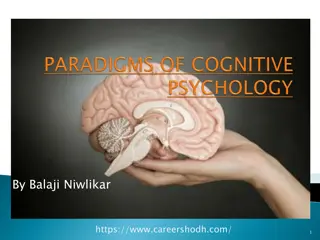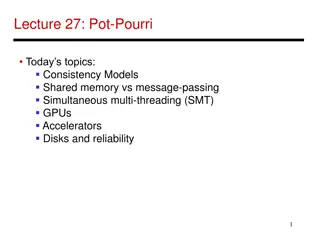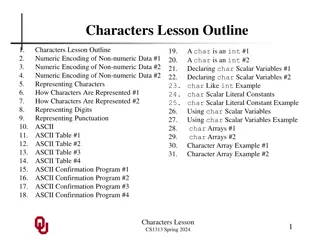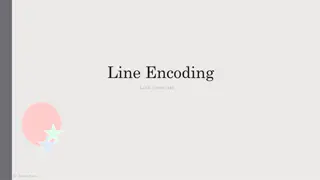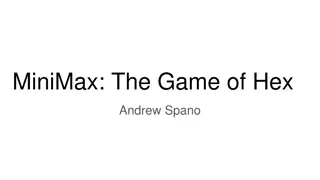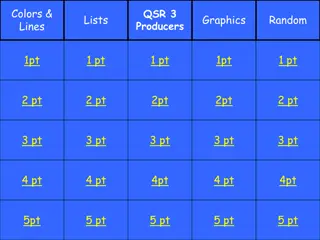Unraveling the Complexities of Hex Game Encoding Paradigms
Hex, a strategic two-player game invented by John Nash and Piet Hein, poses intriguing challenges for mathematicians and computer scientists. This article delves into different paradigms for encoding Hex game rules, exploring the performance of each. From basic observations to advanced approaches like logic programming and power-set constraints, discover the intricate world of Hex analysis and implementation strategies.
Download Presentation

Please find below an Image/Link to download the presentation.
The content on the website is provided AS IS for your information and personal use only. It may not be sold, licensed, or shared on other websites without obtaining consent from the author.If you encounter any issues during the download, it is possible that the publisher has removed the file from their server.
You are allowed to download the files provided on this website for personal or commercial use, subject to the condition that they are used lawfully. All files are the property of their respective owners.
The content on the website is provided AS IS for your information and personal use only. It may not be sold, licensed, or shared on other websites without obtaining consent from the author.
E N D
Presentation Transcript
What is Hex? Hex is a two-player game invented by John Nash and Piet Hein (independently). Players take turns placing tiles on any cell of their choosing. Players win by connecting a chain of tiles, such that they form a line spanning from one edge of the board to the opposite edge. Hex is a game commonly studied by Mathematicians in Computer Science in order to shed light on topics including: graph theory, combinatorics, game theory, and AI. In 11 11 Hex, there are approximately 2.4 1056possible legal positions! (Approximated using an exponential function and branching factor analysis)
What are we Investigating? What are the different paradigms in which we can encode the rules of Hex? How does each paradigm perform (relatively)?
Why Logic Programming? (GDL) Testing Games in a Generalizable Fashion:Logic Programming is the methodology of describing games in the field General Gameplaying. GDL is widely accepted as the language of General Gameplaying! Condition Testing:We are really just solving a condition problem, namely: given this set of data, is X true? Logic Programming is very good for that! Avoiding the background implementations : In a traditional imperative programming language, we would have to focus on building the back- end framework from game-to-game; logic programming avoids that!
General Observations: We can assign each cell in the Hex board a numerical index. 8 4 5 9 1 2 7 3 6 10 19 In this way, we can codify mathematical rules defining adjacency: 28 37 E.g. Cells X & Y are adjacent if Y = X + 1 46 One tile must be in each column (or row) in order for a player to have won (as a necessary, but notsufficient condition) 55 64 73
Approach #1: Nave Implementation What if you abstracted half of the problem away from logic programming? Use logic programming as a verifier and another language (Python) to generate the Winning Sets . E.g. {1,2,3,4,5,6,7,8,9} After every move, check if the cells controlled by a given player is a superset of the winning set.
Approach #2: Power-set Constraints {28, 2, 12, 13, 42, 16, 8, 45} 65 ? ? 10 ? 8 5 34 2 73 46 67 {55, 11, 3, 31, 21, 42, 8, 27} 74 ? ? 18 ? + 1 1. Maintain set of all cells controlled by player p 2. Generate all* 9-length subsets s.t. each??(element in the ith position) is a member of the ith column 3. For each element in a set, check if the subsequent element obeys an adjacency rule. *To avoid repeatedly checking non-winning sets, one can preserve all previous non-winning sets and check all new sets generated by replacing the corresponding column entry in the previously generated sets E.g. If you play in Column 6 (6) ???? (6)}in all sets {????
Power-set Constraints: Worst-Case Analysis Note: {28, 2, 12, 13, 42, 16, 8, 45} What if we generated all 9-length subsets without our unique column restriction? {55, 11, 3, 31, 21, 42, 8, 27} Suppose player p controls n cells (nmax = 81): 260887834350 387420489 81 9 2. Generate all 9-length subsets s.t. each??(element in the ith position) is a member of the ith column 99 vs. x674 more computations!
But wait! It isnt that simple! This winning sequence is 61 tiles long!
Approach #2: Power-set Constraints* {28, 2, 12, 13, 42, 16, 8, 45} 65 ? ? 10 ? 8 5 34 2 73 46 67 {55, 11, 3, 31, 21, 42, 8, 27} 74 ? ? 18 ? + 1 1. Maintain set of all cells controlled by player p 2. Generate all* 9-length subsets n- length subsets [9, 61], s.t. each ??(element in the ith position) is a member of the ith column 3. For each element in a set, check if the subsequent element obeys an adjacency rule. ? 9?
Approach #3: Following the Line Column 2 Column 3 ? 8 ? 8 56 57 Column 1 28 64 ? + 1 65 ? + 1 66 ? + 10 74 ? + 10 76 64 1. For a given player p, consider each cell they control in column 1 (Indices: 1, 10, 19, ,73) 2. Using the adjacency rules, compute all in the next column (column i + 1) that would be adjacent to the current cell (in column i). 3. If player p controls any of the adjacent cells, repeat the adjacency check. If you can follow the line all the way to the end column, the player has won!
MRG approved Approach #4 : Minimal Spanning Tree 1. Define a connected relation: connected(TREE_NUM, ROW, COL) 2. After each turn, update the connected relations in the dataset: 3. The game is won if there is some set of connected relations s.t. there exists some connected(NWIN, R1, C) and connected(NWIN, R8, C) (with analogous reasoning extending to spanning a column). This set of connected relations defines the eponymous minimal spanning tree Credit: M. Genersereth, CS 151, Lecture 12 (Optimization)
Beyond the Paradigm: General Optimization Techniques (GOT) Grounding: Sub-goal Reordering: Sub-goal Pruning:
GOT Efficiency Analysis?: Conjecture: The majority of the time is spent in verifying whether a victory exists or not. Technique: Devise a particularly difficult example, and see if the verifier can(not) detect a victory. Analysis was conducted on a board with 34 tiles filled, and no victory determined.
Without grounding and sub-goal reordering With grounding and sub-goal reordering
Hex as a Maker-Breaker Game A Maker-Breaker game can be thought of a game with two distinct players: Maker: wins by taking elements from a finite set until they have a winning set Breaker: wins by stopping the Maker Framing Hex as a Maker-Breaker game: Don tthink: Has Red won? Has Blue won? Think: Has Red won? Has Red lost? (Can Red still win?) Hex implementation: After each play, populate all blank cells with red tiles On Blue s turn, if a red path still exists, then Red hasn t lost On Red s turn, if a red path still exists, then Red can still win! Maker-Breaker general strategy: populating available moves with Maker s moves








